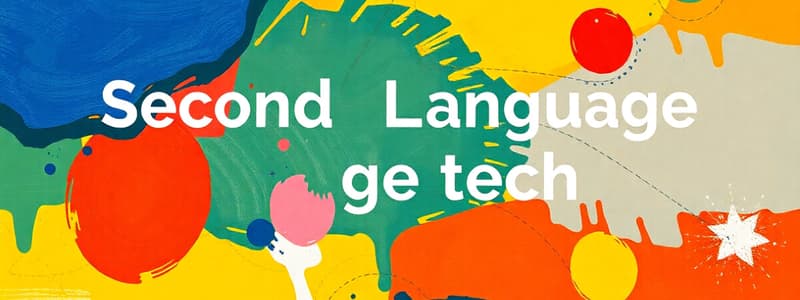Podcast
Questions and Answers
What is the main focus of observing learning and teaching in the L2 classroom?
What is the main focus of observing learning and teaching in the L2 classroom?
- Measuring students' intelligence levels
- Developing standardized grammar tests
- Comparing monolingual and bilingual students' performance
- Understanding how second languages are taught and acquired in classroom settings (correct)
What are the two main types of L2 learning settings discussed?
What are the two main types of L2 learning settings discussed?
- Phonetic and syntactic learning
- Group learning and individual tutoring
- Natural acquisition and instructional settings (correct)
- Online and offline learning
What characterizes natural acquisition settings?
What characterizes natural acquisition settings?
- Errors are immediately corrected by instructors
- Learners study vocabulary lists and grammar rules
- Language is learned through real-life interactions without formal instruction (correct)
- Grammar is explicitly taught in a structured manner
What is a key feature of structure-based instructional settings?
What is a key feature of structure-based instructional settings?
How do communicative instructional settings differ from structure-based settings?
How do communicative instructional settings differ from structure-based settings?
What is the main purpose of the COLT (Communicative Orientation of Language Teaching) Scheme?
What is the main purpose of the COLT (Communicative Orientation of Language Teaching) Scheme?
What are the two main parts of the COLT Scheme?
What are the two main parts of the COLT Scheme?
What does the COLT Scheme examine in classroom settings?
What does the COLT Scheme examine in classroom settings?
What is corrective feedback in language learning?
What is corrective feedback in language learning?
What is an example of explicit correction?
What is an example of explicit correction?
What is a recast in corrective feedback?
What is a recast in corrective feedback?
What is a limitation of recasts?
What is a limitation of recasts?
What is an elicitation technique in corrective feedback?
What is an elicitation technique in corrective feedback?
What is the main goal of metalinguistic feedback?
What is the main goal of metalinguistic feedback?
What was a key finding of Oliver and Mackey's (2003) study on corrective feedback?
What was a key finding of Oliver and Mackey's (2003) study on corrective feedback?
What did Sheen's (2010) study reveal about written vs. oral corrective feedback?
What did Sheen's (2010) study reveal about written vs. oral corrective feedback?
What are the two main types of teacher questions?
What are the two main types of teacher questions?
What is a display question?
What is a display question?
What is a referential question?
What is a referential question?
What did Long and Sato (1983) find about teachers' question types?
What did Long and Sato (1983) find about teachers' question types?
What is the significance of wait time in questioning practices?
What is the significance of wait time in questioning practices?
What is ethnography in language learning research?
What is ethnography in language learning research?
What did Watson-Gegeo's (1992) study on home and school language use find?
What did Watson-Gegeo's (1992) study on home and school language use find?
What is communicative competence?
What is communicative competence?
What is pragmatic competence?
What is pragmatic competence?
What is one challenge in achieving near-native L2 competence?
What is one challenge in achieving near-native L2 competence?
Why might learners prioritize functional language use over native-like competence?
Why might learners prioritize functional language use over native-like competence?
Why is it important to consider individual goals in L2 learning and teaching?
Why is it important to consider individual goals in L2 learning and teaching?
What is a key implication for L2 teaching based on research findings?
What is a key implication for L2 teaching based on research findings?
Why is patience important in L2 learning?
Why is patience important in L2 learning?
Flashcards
L2 Classroom Observation
L2 Classroom Observation
Understanding how L2s are taught and acquired in classrooms.
Natural Acquisition
Natural Acquisition
Learning via real life interactions without formal teaching.
Structure-Based Instruction
Structure-Based Instruction
Formal teaching, focusing on grammar and vocab step by step.
Communicative Instruction
Communicative Instruction
Signup and view all the flashcards
COLT Scheme Purpose
COLT Scheme Purpose
Signup and view all the flashcards
COLT Analysis Focus
COLT Analysis Focus
Signup and view all the flashcards
Corrective Feedback
Corrective Feedback
Signup and view all the flashcards
Explicit Correction
Explicit Correction
Signup and view all the flashcards
Recast
Recast
Signup and view all the flashcards
Recast Limitation
Recast Limitation
Signup and view all the flashcards
Elicitation
Elicitation
Signup and view all the flashcards
Metalinguistic Feedback
Metalinguistic Feedback
Signup and view all the flashcards
Oliver & Mackey (2003) finding
Oliver & Mackey (2003) finding
Signup and view all the flashcards
Sheen's (2010) study
Sheen's (2010) study
Signup and view all the flashcards
Display Questions
Display Questions
Signup and view all the flashcards
Referential Question
Referential Question
Signup and view all the flashcards
Long & Sato (1983) finding
Long & Sato (1983) finding
Signup and view all the flashcards
Wait Time Significance
Wait Time Significance
Signup and view all the flashcards
Ethnography
Ethnography
Signup and view all the flashcards
Watson-Gregeo (1992)
Watson-Gregeo (1992)
Signup and view all the flashcards
Communicative Competence
Communicative Competence
Signup and view all the flashcards
Pragmatic Competence
Pragmatic Competence
Signup and view all the flashcards
L2 Challenge Example
L2 Challenge Example
Signup and view all the flashcards
Functional Language Priority
Functional Language Priority
Signup and view all the flashcards
Individual Language Goals
Individual Language Goals
Signup and view all the flashcards
Key Implication
Key Implication
Signup and view all the flashcards
Patience Importance
Patience Importance
Signup and view all the flashcards
Two Main L2 Learning settings
Two Main L2 Learning settings
Signup and view all the flashcards
Structure-Based Setting
Structure-Based Setting
Signup and view all the flashcards
Two parts of COLT scheme
Two parts of COLT scheme
Signup and view all the flashcards
Study Notes
- The main focus of observing learning and teaching in the L2 classroom is understanding how second languages are taught and acquired in classroom settings.
- The two main types of L2 learning settings discussed are natural acquisition and instructional settings.
- Natural acquisition settings are characterized by learning through real-life interactions without formal instruction.
- A key feature of structure-based instructional settings is that grammar and vocabulary are taught systematically in isolated steps.
- Communicative instructional settings differ from structure-based settings because they focus on interaction and using language in meaningful contexts.
- The main purpose of the COLT (Communicative Orientation of Language Teaching) Scheme is to analyze classroom interactions and teaching practices.
- The two main parts of the COLT Scheme are teaching practices and language use analysis.
- The COLT Scheme examines teaching methods, student participation, and error correction strategies in classroom settings.
- Corrective feedback in language learning involves providing responses to learners' errors to facilitate improvement.
- An example of explicit correction is directly stating what is incorrect and providing the correct form.
- A recast in corrective feedback involves reformulating a student's incorrect sentence without directly pointing out the mistake.
- A limitation of recasts is that students may not notice the correction.
- An elicitation technique in corrective feedback involves prompting students to self-correct their mistakes.
- The main goal of metalinguistic feedback is encouraging learners to reflect on grammar rules without providing the correct form.
- A key finding of Oliver and Mackey's (2003) study on corrective feedback revealed that explicit language-focused exchanges led to the most learner modifications.
- Findings from Sheen's (2010) study reveal that explicit corrective feedback is more effective than recasts in both oral and written forms.
- The two main types of teacher questions are display and referential questions.
- Display questions are those where the teacher already knows the answer.
- Referential questions are those where the teacher does not know the answer in advance.
- Long and Sato (1983) found that teachers used more display questions than referential questions.
- The significance of wait time in questioning practices is that longer wait times lead to more complex student responses.
- Ethnography in language learning research involves a qualitative approach to observing teaching and learning in natural settings.
- Watson-Gegeo's (1992) study on home and school language use found that differences between home and school language use affected student success.
- Communicative competence is the ability to use language appropriately in social and cultural contexts.
- Pragmatic competence involves understanding how to convey and interpret meaning in social interactions.
- One challenge in achieving near-native L2 competence includes that pronunciation and grammatical intuition remain difficult to master.
- Learners might prioritize functional language use over native-like competence because practical needs, such as professional and social communication, may be more important.
- It is important to consider individual goals in L2 learning and teaching because different learners may prioritize different aspects of language, such as communication, accuracy, or cultural integration.
- A key implication for L2 teaching based on research findings is that there is no single "best" method, and instruction should be adapted to learners' needs.
- Patience is important in L2 learning because language acquisition is a gradual process that requires time and incremental progress.
Studying That Suits You
Use AI to generate personalized quizzes and flashcards to suit your learning preferences.




